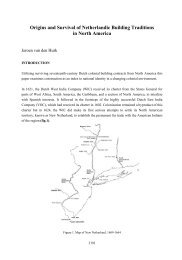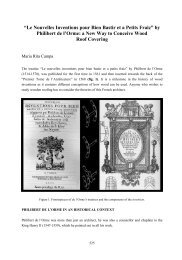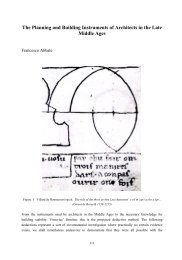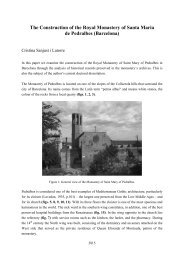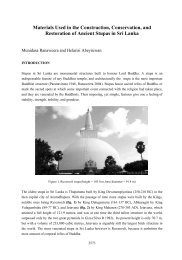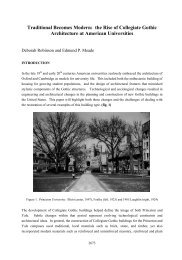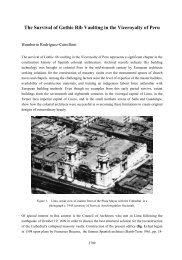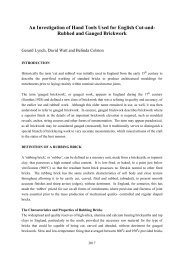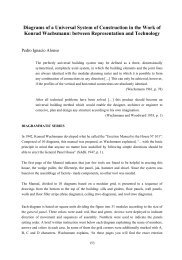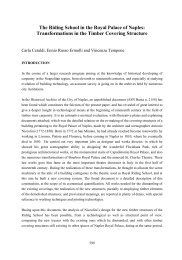bricks from the - Department of Architecture
bricks from the - Department of Architecture
bricks from the - Department of Architecture
You also want an ePaper? Increase the reach of your titles
YUMPU automatically turns print PDFs into web optimized ePapers that Google loves.
18<br />
1820 and 1868, Callendar Briek Company, Callendar Coal Company,<br />
Callendar Briekworks, Callendar Firebriek and Til~ Works, Glen<br />
Brickworks. 1868-99 partnership <strong>of</strong> James Dougall, James Potter,<br />
and William Hamilton, with Dougall as managing direetor. He persuaded<br />
<strong>the</strong> partnership to pay an annual rent <strong>of</strong> £2,000 to <strong>the</strong> owner<br />
<strong>of</strong> <strong>the</strong> Callendar Estate in order to maintain and expand <strong>the</strong> briekworks.<br />
In 1899 a eompany was f~rmed to take over <strong>the</strong> business and<br />
property <strong>of</strong> <strong>the</strong> partnership. Ownership <strong>of</strong> <strong>the</strong> eoal mine and briekworks<br />
passed to <strong>the</strong> National Coal Board upon nationalisation in<br />
1948. In 1960 tile produetion eeased, but <strong>the</strong> works manager, Mr'<br />
Stewart, eontinued briekmaking until 1980 with a workforee redueed<br />
<strong>from</strong> 170 to 15. By <strong>the</strong>n, oil priees had made <strong>the</strong> old kilns expensive<br />
to run, and <strong>the</strong> deeline in housebuilding foreed <strong>the</strong> works to elose<br />
in Oetober <strong>of</strong> that year. (Sanderson)<br />
DEWAR: Dewar and Findlay Ltd, Drumpark Briekworks, Bargeddie, Glasgow<br />
(NR 705641). Operated <strong>from</strong> 1895 to 1977, produeing high quality<br />
pressed red facings, ei<strong>the</strong>r red or blue. Used widely throughout<br />
Seotland (Douglas; Ramsay).<br />
SOUTHHOOK KILMARNOCK: Made at one <strong>of</strong> several works operated by <strong>the</strong><br />
Southhook Potteries Company in <strong>the</strong> Kilmarnoek<br />
area (Crosshouse was one), ~1900-75. The eompany also made sanitary<br />
ware and had an interest in coal mining (Douglas).<br />
SYMINGTON: Kipps Quarries and Briekworks, Coatbridge, c.1870-l9l0,<br />
produced high quality pressed red faeings. Exact site <strong>of</strong><br />
works not known.<br />
For information on <strong>the</strong> above I am indebted to: Graham J. Douglas <strong>of</strong><br />
<strong>the</strong> Scottish Indtistrial Arehaeology Survey.,'<strong>Department</strong> <strong>of</strong> History,<br />
University <strong>of</strong> St'ra<strong>the</strong>lyde; <strong>the</strong> Rev. Ian G.' Ramsay, Beattoek; J.M.<br />
Sanderson, Curator, Falkirk Museums; Mrs W.A.Los, Beverley; and Mr<br />
E.Marsh, Peterborough.<br />
A DUNNACHIE, GAS-FIRED CONTINUOUS KILN, POOLE<br />
Martin<br />
D. P. Hammond<br />
A watch was kept on <strong>the</strong> Poole Commerce Centre (~ Bourne Valley<br />
Pottery) site while ground works were proeeeding earlier this year.<br />
The existence <strong>of</strong> a kiln <strong>of</strong> this type was suspeeted <strong>from</strong> old maps<br />
and photographs, and proven when drainage trenehes were dug in both<br />
directions aeross <strong>the</strong> kiln site.<br />
Sharp, Jones and Company started <strong>the</strong> Bourne Valley Pottery on<br />
this site in 1853, making salt-glazed stoneware drainpipes and<br />
fittings, ehimney pots, <strong>bricks</strong>, and tiles. The works was modernised<br />
in <strong>the</strong> l880s, <strong>the</strong> original Staffordshire-type 'bottle ovens' being<br />
eonverted to downdraught operation, and a new briekmaking plant with<br />
a Dunnachie gas-fired continuous kiln built. The kiln -was patented<br />
in 1881 by James Dunnachie, managing director <strong>of</strong> <strong>the</strong> world-famous<br />
fireclay works at Glenboig near Coatbridge in Scotland. It was <strong>the</strong><br />
first Successful gas-fired kiln. Dunnachie did not encourage <strong>the</strong> use<br />
<strong>of</strong> his patent in Britain for fear <strong>of</strong> competition, but must have made<br />
an exception in this case, provided that his fire<strong>bricks</strong> were used in



